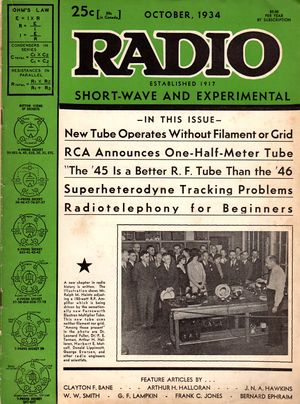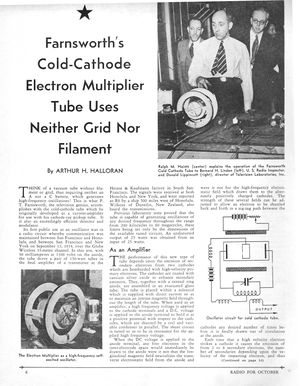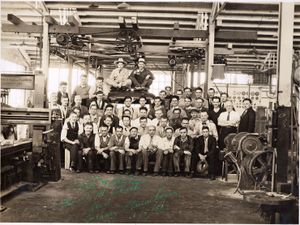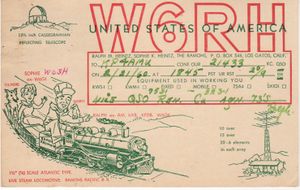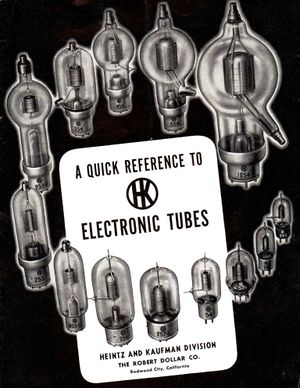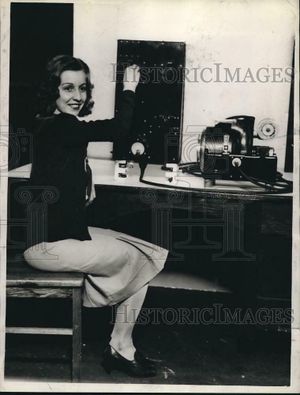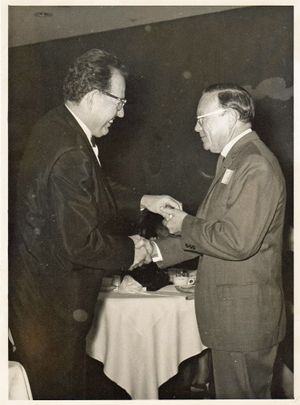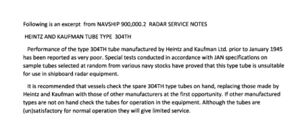Heintz and Kaufman
This entry is dedicated to the Heintz and Kaufman manufacturing business.
Start-up
Although this wiki focuses on the history of Heintz & Kaufman Co., the years prior to that partnership have relevance.
Much is known of the history of Ralph Heintz as it pertains to his later business ventures but little information is available on his early association with Hermann Kohlmoos in San Francisco. Perhaps their partnership helped form the business acumen that Ralph Heintz showed in later years.
HEINTZ & KOHLMOOS
The 1920's brought new opportunities for home hobbyists who were building and experimenting with home-made broadcast receivers, parts for which were sold through advertising in magazines and over-the-counter at stores across the US.
In 1920 an advertisement for radio parts appeared in RADIO Magazine, showing Heintz & Kohlmoos at 606 Mission Street in San Francisco. By 1922 the firm was operating at 217 Natoma Street; advertisements in Radio Magazine Sept., 1925 and QST magazine Nov. 1, 1926 show the firm selling tuned-plate tuned-grid receivers.
The 1925 edition of White's Callbook shows AM station KFPV licensed to Heintz & Kohlmoos in San Francisco for the frequency of 236M (1270kHz) at 50 Watts; anecdotes however suggest this station was never on-air1.
In a 2022 communication with Jan Kohlmoos, it was revealed to Reid Brandon that her father, Hermann Kohlmoos Jr., had held amateur radio license W6ISO but to her knowledge her grandfather Hermann Sr. was never a licensed radioamateur. She also indicated Ralph Heintz married the senior Kohlmoos's sister, Sophie Kohlmoos, making Hermann his brother-in-law.
HEINTZ & KAUFMAN
Quoting from Tim J. Sturgeon's Thesis for his Masters degree it states: "In 1924, Heintz asked a former classmate from Cal Berkeley, Jack Kaufman, to come into his business as a partner, thereby creating Heintz and Kaufman Company (H&K)."
Sometime around 1925 Hermann Kohlmoos sold his interest in the Heintz-Kohlmoos partnership to Jack Kaufman. An advertisement2 in Radio Magazine May 1927 showed Heintz & Kaufman's address as 219-221-223 Natoma St., next door to the Heintz-Kohlmoos address. This was a few blocks South of Market Street, noting the entire 200 block of Natoma is now gone, lost to development over the years.
Radio Magazine grew to become a popular publication for amateur radio hobbyists and consumers of broadcast receivers; in the May, 1936 edition Gerald M. Best, as technical advisor, published "The Ideal Ham Set" while in the same issue Heintz & Kaufman ran a full page advertisement for a kit of parts for constructing the Ham Set, clearly in collaboration with the publisher.
South San Francisco was home for the H&K factory in the 1930's, it was located adjacent to the DuPont paint factory. South San Francisco today is still known as "The Industrial City" and a large signage exists along the hillside of Mt. San Bruno which separates South San Francisco from the neighboring San Francisco City and county.
Enter Philo Farnsworth
Ralph Heintz had a friendship with a nearby inventor, Philo Farnsworth. It has been said they met occasionally to discuss their projects.
Farnsworth had been financed by George Everson and in 1926 moved from Salt Lake City to San Francisco with his new bride and started to develop his all-electric television set, a concept he must have described to Everson. Farnsworth's patent no. 1,733,980 (filed Jan.7, 1927) for a "Television System" was granted Aug. 26, 1930. Everson became director of the UC Berkeley Radiation Laboratory where Ernest Lawrence was a key physicist in the development of the Cyclotron. Lawrence would later claim to have developed a black-and-white television prior to Farnsworth and in 1948 he introduced Farnsworth to his boss while working on his dream of color television. The SF Bay Area would become the place where color television became entangled with large corporate efforts to get patents issued that would meet FCC requirements, thus enabling the new technology to be sold to consumers. The complex history of this is well documented here.
Ralph Heintz demonstrated an interesting device designed by Philo Farnsworth, a "Tube without a filament or grid!" and it was actually the first working example of Multipactoring, a phenomenon that is of important concern in today's high power rf used for accelerators, communications etc. since uncontrolled multipactoring can cause failure in those devices. A picture of Heintz demonstrating the device to Dr. Frederic Terman and others is shown on the cover of the Oct. 1934 Radio and Shortwave Experimental Magazine, any copyright is acknowledged.
Heintz and Farnsworth both used Donald K. Lippincott as their patent attorney. Farnsworth is the father of the television video tube and he fought RCA for years over a patent battle with Zworkin who had the backing of RCA and claimed he invented television.
Of interest also is Farnsworth in his early development years hiring college students to work in his laboratory. One of them was Russell Varian, perhaps this helped form an interest in technical work in later years with his brother Sigurd as they developed the Klystron.
2010 marked Discovery of Only Known Photo of H&K Factory
Around 2010 a box of documents and photographs was uncovered, it had been collected by Mr. Marshall Loring of Eimac, he was the last manager of the "Eimac'ers Retiree Gatherings" which ceased after his retirement. Archival material was given to Reid Brandon leading to writing this wiki.
In the materials was an 8X10 b&w photo of the Heintz & Kaufman factory in South San Francisco. Dated 6/7/1935 and was presented to Mr. Irv Coutts.
Along with the photo was a lengthy letter describing the life of Mr. Coutts, by his wife "Ginny" whom he later met at Eimac. Its all very touching to read her description of their meeting, getting married and working in the same place. That letter and photograph is reproduced here with permission.
The following is inscribed on the photo of the Heintz & Kaufman team:
"Best Wishes to Mr. I. M. Coutts from Henry Guccuhagen (sp?) 6/7/1935"
Additional notes by Ginny Coutts: "South City before Eimac.
First row 2nd O.P. Taylor, 3rd Irv Coutts, 2nd row 4th George Wunderlich"
(Front row 6th from left is Ralph Heintz (wearing white shirt with tie).
note: Bill Eitel joined H&K in 1929 and Jack McCullough followed in 1930 and both men left H&K in 1934, the year before this photo was taken.[1] O.P. Taylor and Irv Coutts would later become Eitel McCullough employees in production and George Wunderlich became Eitel McCullough's general manager in Nov. 1944.
RALPH HEINTZ EARLY YEARS
From 1915 to 1917 Ralph M. Heintz was in college, first at U.C. Berkeley then Stanford Univ. When WW1 broke out he enlisted in the U.S. Army Signal Corps Aviation Section. After 1918 he returned to Stanford where he graduated with a degree in Chemical Engineering in 1920. [2]
In May of 1922, at the age of 30, Heintz was the upstart chief engineer of KFDB, a radio station operated by a Bank in San Francisco. Heintz and his staff built a transmitter using a 50 Watt exciter followed by a 1 kilowatt linear amplifier, the first known application of a linear amplifier in the final stage by any broadcast station at that time. The station was plagued with problems and shut down after having been in existence just over a year. As John Schneider says on his webpage theradiohistorian.org: "These (stations) weren't like the stations we know today; rather, they stood with a foot in the world of broadcasting and a foot in amateur radio"[3] thanks to John for documenting the history of many small broadcasting stations in the budding years of broadcast. He based some information on Ralph Heintz's writings from his archives.
Amateur radio connections
Like many of the engineers, craftspersons and technicians of his era, Ralph Heintz was an avid radio amateur.
What tales his QSL card could tell! But there is no proof that Ralph Heintz was licensed 6XB, more likely he operated as a student from the club station 6XB at UC Berkeley. (The University of California Amateur Radio Club Berkeley was licensed as 6XB in 1914, as 6BB and 6XM in 1920, and is still active under the calls W6BB and NU6XB).
There is a rich history of Ralph Heintz being licensed with numerous calls at various times.
The first was as 6AUQ in 1921 while he lived at 653 Miramar Ave. in SF then in 1924 as 6GK at 119 26th Ave, SF, then in 1926 as 6XBB (portable) at the same address.
Note that commercial/experimental license 6XBB was issued to "Dollaradio", moniker for the Stateside station built to communicate with Dollar Ships. Built at Mussel Rock (on the Pacific coast West of Pacifica California), the transmitters were housed in a small wooden building about 20 feet square, and receiving operations were conducted in a similar structure 100 feet away. source: https://www.radiomarine.org/incredible-radio-tales/robert-dollar
The building at the Dollaradio site was incorporated by the State of California as "Dollaradio Historical Station" but the structure has been threatened by the sea eroding the land it sits on but the Coastal Committee prevented the owner from taking remedial steps to protect it from further erosion. see: https://www.mercurynews.com/2011/08/22/another-pacifica-property-threatened-by-bluff-erosion/
The 1928 callbook shows 6GK still assigned to Ralph and his wife Sophie licensed 6GI, later they would be licensed W6GK and W6GI.
W6XF was an experimental license issued to the Heintz & Kaufman Co. in 1936-1937 for portable operation and W6XBB was an experimental license issued to Ralph in San Francisco then finally, in 1959 Ralph was relicensed as W6RH, Sophie as W6SH. Thanks to Friedrich Sommer, K6EE for this research.
Of many radio amateurs working for Heintz & Kaufman were the very notable pair, Bill Eitel, 6UF and Jack McCullough, 6CHE who both left H&K in 1934 to form Eitel McCullough Inc. (ultimately EIMAC) and eventually became very successful when the US Government needed special electron tubes to support technology developed during WW2, especially early radar systems.
Shown in the 1935 archival photo is Irv Coutts, W6HTR, whose wife Virginia supplied the photograph. Additional photos and history of these two employees are included in the ethw eimac wiki.
Norm Wilson, N6JV, has an extensive collection of tubes including many rare examples made by Heintz & Kaufman. He covers the rare gridless HK54 Gammatron[4] and has an excellent website with detailed information and photos of gridless Gammatrons.[5]
An account of Ralph's miniature railroad on his property on the San Francisco Peninsula is well documented and includes info on his estate.[6]
RCA
The late 1920's was a busy time with new technologies popping up around developments in radio communications. Thanks to Lee DeForests' inventing the vacuum tube there were numerous firms (on the East Coast USA) manufacturing diodes, triodes and tetrodes for receiving and transmitting equipment all under the DeForest's patent protection which later became property of RCA.
The Radio Corporation of America rose rapidly after its creation in 1919 to become one of the largest manufacturers of radio receivers and transmitters; the sales of vacuum tubes were a major profit source for RCA so they vigorously enforced and defended their patents.
Ralph Heintz circumvented RCA's patent issues by developing a tube that did not use a grid of the conventional type which allowed electrons to pass through it on their path to the anode. His design used an electrode that deflected electrons onto or away from the anode. This technique proved to be far less efficient than a conventional triode but it was a working solution.
Being a chemical engineer, Heintz probably lacked much of the formal knowledge in the field of electrical engineering but in those days an experimental approach was often employed; taking a conceptual idea to making a prototype with little or no mathematical analysis, the so-called empirical or "cut-and-try" method succeeded in making many working products.
With but a few exceptions, there is no record of the employees hired to work at H&K other than anecdotal information but the staff there had to be very diversified and multi-skilled, manufacturing electron tubes in the same plant where transmitters and receivers were assembled was quite an accomplishment.
Patents
On May 30, 1930, months before the Great Depression, H&K applied for US patent no. 301,759 for the GAMMATRON trademark (signed by Jack Kaufman, VP of Heintz and Kaufman Ltd). It is interesting to note the address used, 311 California St. in San Francisco. That was the headquarters of the Dollar Steamship Corporation which became one of H&K's largest customers and the Robert Dollar Co. ultimately acquired a portion of the H&K business. The 1936-1937 San Francisco Manufacturing Registry for Business shows: "Heintz & Kaufman, Ltd., Radio Apparatus, Wireless Equipment, 311 California St., San Francisco"[4] . This is the address for the office building built by Robert Dollar in 1916 and notably in 2022 the structure is still there with its gold-filled lettering in the stones above the arched entrance proudly stating "Robert Dollar Building" (see: https://www.foundsf.org/index.php?title=Captain_Robert_Dollar)
The H&K Trademark was reassigned twice to the Robert Dollar Co. of San Francisco, first on Nov. 1, 1949 then again Sept. 30, 1950.
RCA eventually sued Heintz & Kaufman over alleged patent infringement and when faced with H&K's strong defense with Frederick Terman ScD, the respected Stanford University professor of Electrical Engineering on their side, RCA withdrew their case.[7] This allowed H&K to continue manufacturing Gammatrons as well as conventional triodes.
H&K employed Ralph C. Shermund. Mr. Shermund had worked for Federal Telegraph Co. in San Francisco where he patented an important receiver development, patent 1,898,792 filed October 28, 1929.
Later, Shermund's patent 2,093,492 Sept. 21, 1937 (application dated Oct. 21, 1935) among others, was assigned to H&K for making glass-to-metal seals, a critical component in manufacturing glass-envelope vacuum tubes. In 1933 Shermund was chairman of the San Francisco section of the Institute of Radio Engineers, Inc. and his affiliation with H&K certainly carried some prestige to the firm.
It is interesting to note that while employed at H&K, William Eitel and Jack McCullough patented a method for mounting grids in their patent no. US2030362, "Space Charge Device" application dated Nov. 7, 1933 and granted to H&K Feb. 11, 1936. Both men left H&K in 1934 and a short time later they formed Eitel-McCullough where numerous patents would result over the next 5 decades. Surely their employment at Heintz & Kaufman influenced the tube manufacturing business they started in 1935.
Dollar Steamship Co
Any discussion of Heintz & Kaufman would not be complete without including their affiliation with the Dollar Steamship Co, ultimately becoming a division of The Robert Dollar Co! H&K equipment was used aboard the SS Kaimiloa with call sign KFUH when, in April 1925, it made the first coherent shortwave radio contact from a ship (previous contacts were long wave and were using spark technology). A story with a picture of a KFUH QSL card is here.[8] Of interest is the notation on the KFUH card: "Equipment by Heintz & Kohlmoos, San Francisco U.S.A.", directly above the signature of Fred G. Roebuck, opr. in charge, dated May 21, 1926.
As a result of successful communications with the SS Kaimiloa, a personal schooner that roamed the South Seas, in 1927 the Dollar Steamship Co. began equipping all of their many ships with Heintz and Kaufman shortwave radios. A great resource of information on the Dollar company and the Heintz and Kaufman relationship can be found at the radiomarine.org website.[9]
The H&K firm has a rich history of manufacturing aeronautical radio transmitters and receivers, Heintz developed specialized transmitters and receivers that were fitted to aircraft, a totally new field at that time. H&K radios were carried on expeditions to distant places including admiral Richard Byrd's polar expeditions and used extensively in Africa while filming Trader Horn, the great Hollywood movie of 1931. The Perham foundation lists some of these accomplishments in their synopsis on Ralph Heintz.[10]
Enter Globe Wireless
On Apr. 10, 1934 the Dollar Company established Globe Wireless as a way of managing the radio network with Jack Kaufman appointed manager while Heintz remained president of H&K. (Sturgeon, Timothy J. “How Silicon Valley Came to Be”, published in Understanding Silicon Valley, Anatomy of an Entrepreneurial Region, Martin Kennedy, editor, Stanford Univ. Press 2000).
After the Dollar Shipping Lines ended, GW, as a new commercial entity no longer affiliated with H&K, continued to operate for the next four decades using Morse code on HF, serving commercial vessels on contract. In the 1980's GW added HF digital packet radio to serve private vessels thereby competing with more costly satellite services.
The last Morse transmissions were on July 12, 1999. GW moved solely into providing data and voice communications with large cargo vessels using satellites. Then, in 2014 GW was acquired by Inmarsat, the large satellite communications company, and HF transmissions were discontinued (see story by Hugh Stegman, NV6H: "Globe Wireless Abandons HF" in Monitoring Times, Sept. 2013 edition p.20).
In 2013 GW had a customer base of 6000 ships with an annual revenue of $91M, a very successful business model that had its roots in 1929 when Dollaradio began operating.
H&K Develops the first Emergency Radio Transmitters?
The use of direction finding equipment, or beacon equipment for Dollar (Lifeboats) looked to be part of the H&K suite but were never fully implemented into the six ocean liners that Dollar commissioned, only two ships were completed because of continued decline in the economy that began with the Great Depression. In 1937 the Dollar Co. was unable to pay taxes, this led the Roosevelt administration to force Stanley Dollar, son of Robert Dollar and then manager of the firm, to turn over 93% of stock in the Dollar Co. to the U.S. Maritime Commission. Dollar Co. declared bankruptcy in 1938 and the once-great shipping company was taken over by the Maritime Commission, later to be reincarnated as the American President Lines.[11].
See photo of an emergency transmitter built by H&K intended for use in the ships. Unknown if a similar device existed prior to this.
EIMAC
Heintz & Kaufman's success in making vacuum tubes spawned the launch of Eitel-McCullough Inc. (registered trademark EIMAC) and ultimately the birth of Silicon Valley.
Of many radio amateurs working for Heintz & Kaufman were the very notable pair, Bill Eitel and Jack McCullough who both left H&K in 1934 to form EIMAC and eventually became very successful when the U.S. Government needed special electron tubes to support efforts during WW2 (see Eimac wiki). Most notable was the VT-127 tube developed for the SC air-search radars used at sea. Both Eitel McCullough and Heintz & Kaufman manufactured these, as did other firms as shown on n6jv's webpage for the VT-127A. Both H&K and Eitel McCullough built the VT-158, the so-called Zahl tube designed by Harold Zahl, an incredible tube with 4 actual triodes which operated with their anodes acting as the tuned output circuit at approx. 600MHz. They were deployed in many AN/TPS-3 radars during WW2 where they operated successfully. Most of the VT-158 samples remaining in collections were made by Eitel McCullough.
Several other radio amateurs employed at Heintz & Kaufman eventually were employed by Eitel McCullough. These included Jim Brown, W6AY, who was head of tube manufacturing at H&K and retired from Eimac in 1975 and Al Clark, W6MUC, who built receivers at H&K. Both men and others were involved with making the first 1296MHz Earth-Moon-Earth communication by radio amateurs in July 1960 when Eimac was a division of Varian Associates. The Eimac radio club still holds FCC license W6AY.
Irv Coutts
Irv Coutts and several other H&K employees left to go to work for Eitel-McCullough Inc. in 1940 since they were rapidly growing and hiring to support new electronic technologies being developed for WW2. Irv Coutts ultimately retired from Eimac in 1985 after 50 years of working in the tube business. File:HK Ginnie Coutts notes.pdf Irv Coutts is the subject of the attached documentary by his wife whom he met as a co-worker at the San Bruno Eimac plant.
Power Line Carrier Systems
An interesting application for Heintz & Kaufman transmitters was in the so-called carrier-current transmission whereby high voltage power transmission lines carry information from a generating station to a central control point many miles distant. This was employed at hydro-electric stations along the Feather River in Northern California where generator status was conveyed to a SF Bay Area control room for the power company PG&E. Information on H&K's transmitters employed for this is discussed in Leonard Fuller's oral history. Information on the massive Feather River electrical generation projects is available here.
More information on carrier-current used on early PG&E power transmission is covered at: https://ethw.org/Telephony_over_Power_Lines_(Early_History).
Heintz and Kaufman go separate ways
Jack Kaufman left H&K in 1946 and, together with Garrett Lewis, started a tube company under their names Lewis & Kaufman, using the Lewis Electronics site located in Los Gatos, CA.[12]
During their productive period Heintz & Kaufman competed with Eitel McCullough with both firms manufacturing the same tube types including the 304TH and 304TL. As a result of government efforts to stimulate competition, in 1942 Eitel-McCullough contracted with the US government to make all their processes and methods of manufacturing available to other tube manufacturers. The government then had other tube manufacturers make the same tube types but they never manufactured as satisfactory a tube as those made by Eitel-McCullough (ref. US Tax court pleadings Dec. 17, 1947). As a result, the US government disallowed use of some H&K triodes in military equipment due to reliability problems (see attached US Navy NAVSHIPS advice).
In 1950 H&K introduced a pentode designated type 257/4E27. Eitel McCullough had already produced a similar tube as type 4E27/5-125B. These were used in a push-pull pair in type AM-14/APT amplifiers manufactured for the US Army and US Navy. Covering the 85-150MHz frequency range, the compact amplifiers were used as airborne radar jammers. H&K had finally moved up to the VHF bands but the end was near. Without further R&D taking place and no longer receiving working capitol from the Dollar Co., H&K withered away in 1953 while the Eitel McCullough operation took the lead as it developed ceramic power grid tubes capable of operating at UHF and microwave frequencies.
OPPORTUNITY BECKONS
In 1940 Ralph Heintz partnered with Bill Jack, a Cleveland OH native, and they started Jack and Heintz Co, JAHCO, manufacturing airplane parts in Maple Heights, OH. From 50 employees in 1940 it grew to 8700 employees in 1944. Precision Products bought them out in 1946 and made both men millionaires. Heintz continued as VP until May 31, 1948 when he stepped down but continued to do R&D. [13]
A detailed history of Jack and Heintz Company is at the ieee.org entry: Jack and Heintz
Finally, an advertisement placed in Radio News, Feb. 1948 p.82, shows an adjustable dipole antenna made by Heintz & Kaufman's "Communications Equipment Division" at 50 Drumm Street, San Francisco, CA. The Robert Dollar Co. also had an office in that building and "was handling all equipment construction in 1936 under the direction of Otto Storm" as described in The Robert Dollar Story part 1 by Edward Prather. It appears 1948 marked the last marketing effort from the organization.
Fine Art Mural
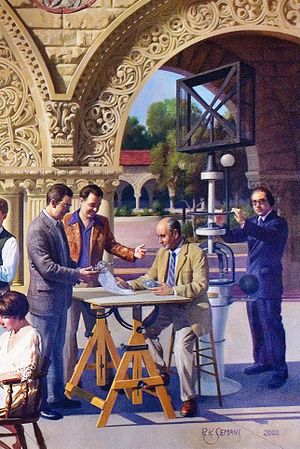
Logo & Trademarks
The H&K logo apparently was in use well after the company closed. Unsure who ultimately made use of the HK logo in the 60's. Another example of debauched use of a logo on modern products.
The "real" H&K Trademark was re-assigned to The Robert Dollar Co. at 311 California Street, San Francisco twice!

Invitation
While this a fresh entry, it's an open invitation to you as readers who may have historic information like photo's, letters, anecdotes and other documents to augment and capture this remarkable history. Get in touch, David k3hz@ieee.org
Further reading & Acknowledgements
Major contributions from Mr. Reid Brandon W6MTF
File:Heinz Kauhmann Gammatron Catalog.pdf
Norm Wilson N6JV Museum
Eimac
https://ethw.org/File:Eimac-cpmt1209a.pdf
Antique Wireless Association Review Volume #10, 1996.
http://perhamcollection.historysanjose.org/heintz-kaufman-gammatron/
https://collections.museumsvictoria.com.au/items/386245
References
- ↑ https://historysanjose.org/perham-collection-creator-profile-eitel-mccullough-inc-eimac/
- ↑ https://oac.cdlib.org/findaid/ark:/13030/tf5k4004wb/
- ↑ http://www.theradiohistorian.org/early.htm
- ↑ http://n6jv.com/museum/articles/hk55.pdf
- ↑ http://n6jv.com/museum/articles/gammatron.pdf
- ↑ https://www.santacruztrains.com/2016/03/rm-heintz-miniature-railroad.html
- ↑ https://artsandculture.google.com/asset/rca-v-heintz-and-kaufman-patent-suit-exhibit-j-ca-1936/8QGuw96sLkK6kQ
- ↑ http://oldqslcards.com/Kaimiloa.pdf
- ↑ https://www.radiomarine.org/incredible-radio-tales/robert-dollar
- ↑ https://historysanjose.org/perham-collection-creator-profile-ralph-heintz/
- ↑ http://www.thepeacefulsea.com/dollar-steamship.html
- ↑ http://pax-comm.com/pa01058.htm
- ↑ https://clevelandhistorical.org/items/show/153
